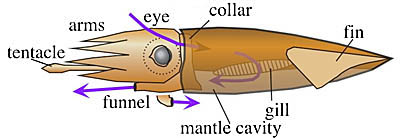If "best" is the same as "tried and recommended by the majority of fish," then the answer is easy. Think of your basic sardine beating its tail back and forth propel itself forward, and you've got it. This undulatory swimming is used by aquatic animals from the size of a pencil eraser to the size of a house, and it is by far the dominant method of locomotion in the ocean (at macroscopic scales, at least).
But there is one whopping exception to the rule: squid, of course. Although they do have fins, and various species undulate these fins to various degrees, they are only a supplement to the real thrust: jet propulsion. The squid sucks water into its body, and squirts it out through a funnel.

(Tolweb has more details)
Jet propulsion is generally considered to be less efficient than undulation. It's not hard to see why. A fish tail beats left-right-left-right and each beat propels the fish forward. A squid, however, moves by jet-refill-jet-refill. Each jet propels the squid forward, but each refilling step actually pushes the squid backward, as it stops and sucks water into its mantle.
At the moment, I'm doing a lot of reading on both the nitty-gritty details and the evolutionary implications of the efficiency of jet propulsion. That's because this week I'm writing up the last of four data chapters for my thesis, and it's all about jet propulsion in squid. My reference list is dominated by a few giants in the field. One is Ron O'Dor, who's been publishing on squid swimming for decades, and did rad experiments with oceanic squid at Dalhousie's Aquatron Laboratory (yes, that is its real name! hee!) in the eighties that are still some of the best data out there. Another is Ian Bartol, a more recent arrival who's been using some very snazz modern techinques to visualize the precise flow of water in squid jets.
Bartol's work has shown that squid jet propulsion can actually be more efficient than we thought, with the clever use of vortex rings. It's complicated fluid dynamics that I don't really want to get into now, so here's the paper.
But even if they use vortex rings, squid still need a huge amount of energy to fuel their jet propulsion, and O'Dor has made the intriguing argument that these high energy needs are what burn squid up so fast--why they mature so quickly and have such short lifespans.
It's an intriguing thought, but I can't help wondering: what about octopuses? They can move by jet propulsion, but rarely do so, trusting instead to their arms to crawl around the seafloor. Intuitively, it seems their energy requirements would be much lower--and yet most still live only a year or less.
Thoughts, anyone?
* This fabulous title comes from a 1991 paper by O'Dor and Webber. It was a comment made in passing as the authors observed that physiologists already familiar with using Bernoulli's equations to model blood flow through a heart could apply those same equations to seawater flow through a squid.




Comments